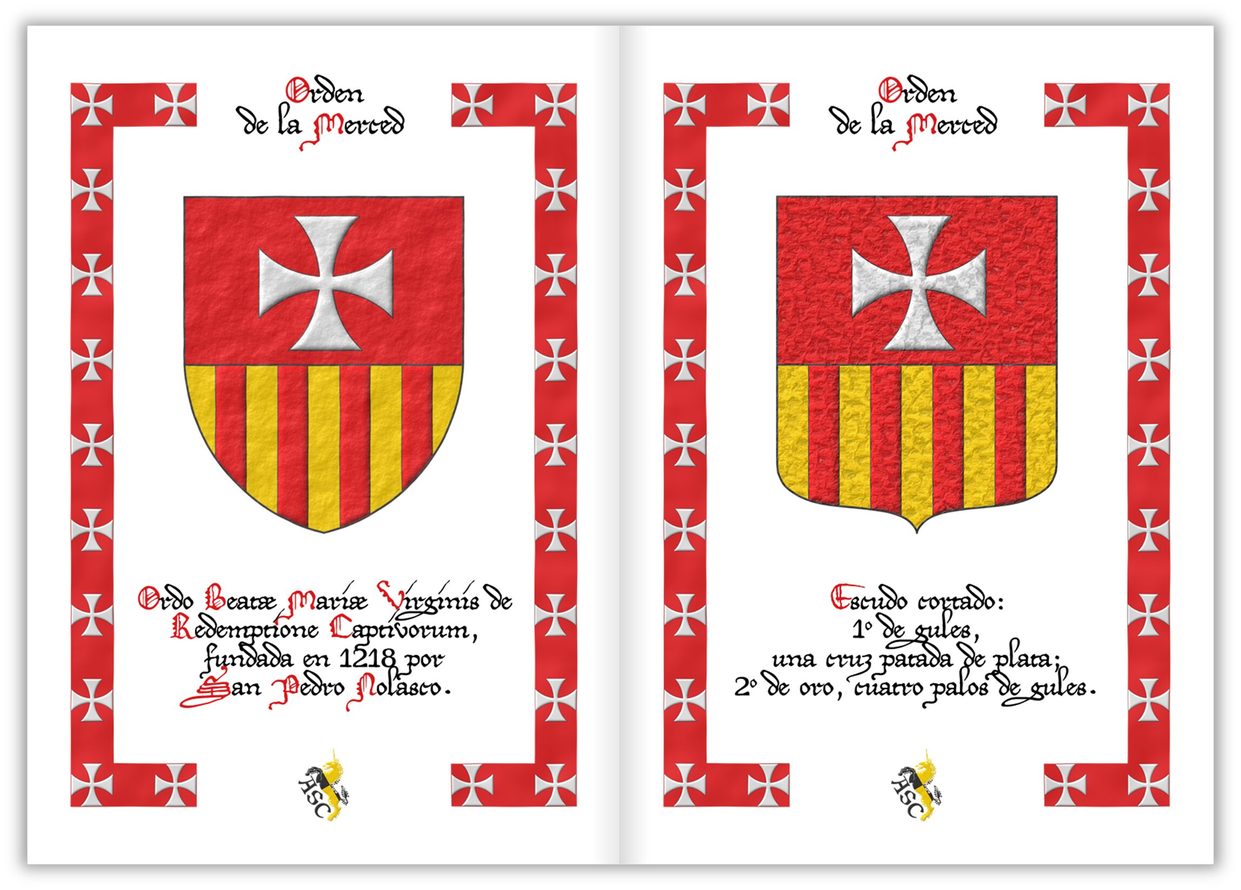
Order of Mercy, pointed and rounded
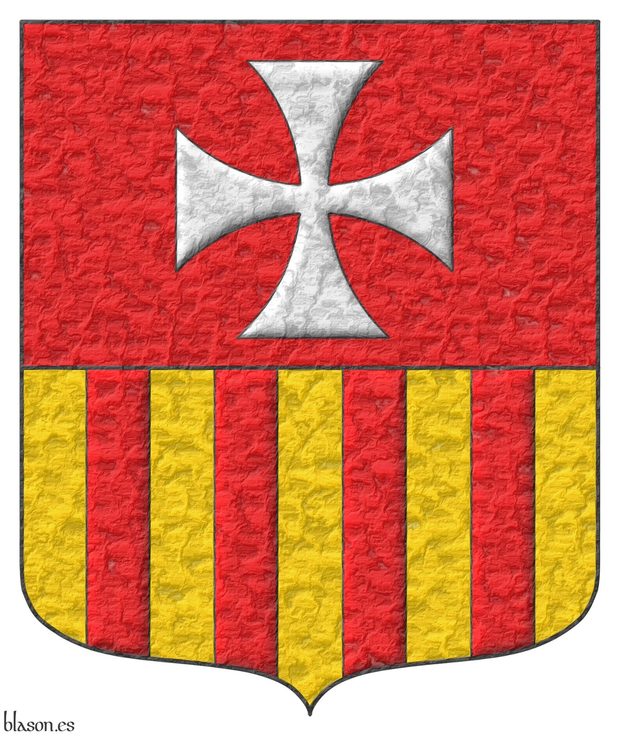
Order founded in 1218 by Saint Peter Nolasco.
Party per fess: 1 Gules, a cross patty Argent; 2 Or, four pallets Gules.
Escudo cortado: 1o de gules, una cruz patada de plata; 2o de oro, cuatro palos de gules.
Already existing arms interpreted by me in the following way: the mouth of the coat of arms is pointed and rounded; its field has been enameled with Gules and Or flat tinctures; the cross patty and the 4 pales are illuminated; and the whole coat of arms has a hammered metal finish.
Blazon keywords: Party per fess, Gules, Or, Argent, Cross, One, Cross patty, Cross couped and Pale.
Style keywords: Ogee, Illuminated, Outlined in sable and Metal beaten.
Classification: Interpreted, Religious and Coat of arms.
Bearer: Our Lady of Mercy, Order of.


Order of Mercy, rounded and crystalline
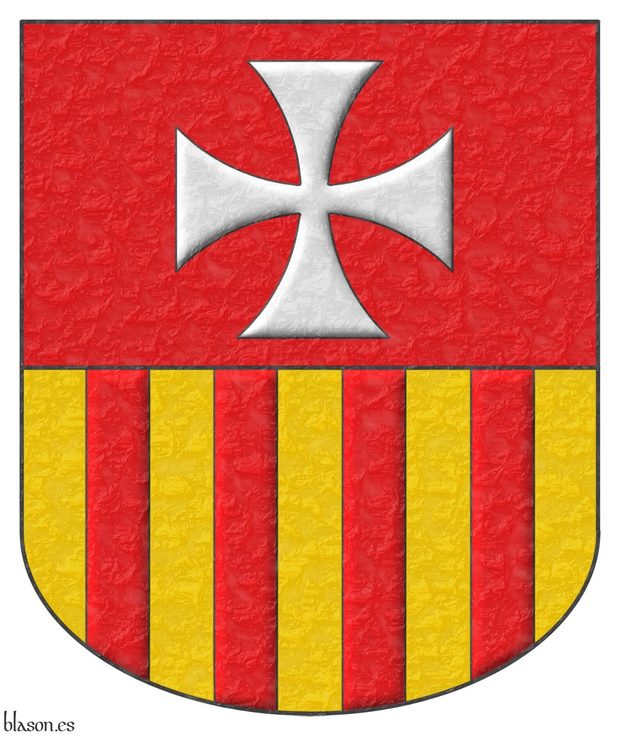
Party per fess: 1 Gules, a cross patty Argent; 2 Or, four pallets Gules.
Escudo cortado: 1o de gules, una cruz patada de plata; 2o de oro, cuatro palos de gules.
Already existing arms interpreted by me in the following manner: the mouth of the coat of arms is rounded in shape; the field has been enameled with Gules and Or flat tinctures; its cross patty and its 4 pales are illuminated; and the whole has received a crystalline finish.
The redemptive mission of the Order of Mercy, founded by Peter Nolasco on August 10, 1218, is represented by a cross Argent, a symbol of innocence and purity, on a field Gules, of blood ready to be shed, and the pales Gules, symbols of love and charity, on a field Or, are an expression of nobility and goodness.
Blazon keywords: Party per fess, Gules, Or, Argent, Cross, One, Cross patty, Cross couped and Pale.
Style keywords: Rounded, Illuminated, Outlined in sable and Crystalline.
Classification: Interpreted, Religious and Coat of arms.
Bearer: Our Lady of Mercy, Order of.


Order of Mercy, rounded and cloth-like
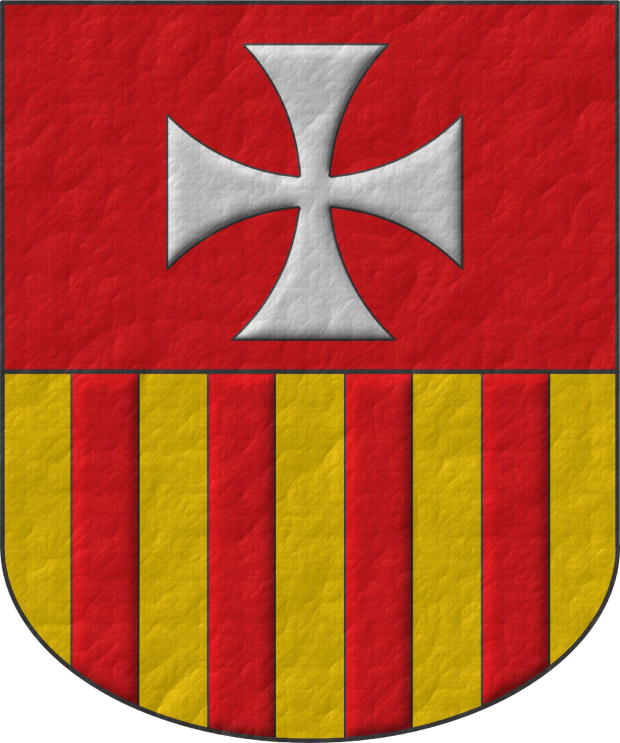
Party per fess: 1 Gules, a cross patty Argent; 2 Or, four pallets Gules.
Escudo cortado: 1o de gules, una cruz patada de plata; 2o de oro, cuatro palos de gules.
These already existing arms have been interpreted with: the mouth of the coat of arms rounded; its field has received an enamel of flat tincture style, of Gules color and Or metal; its cross patty and its 4 pales are illuminated; and the whole coat of arms has received a cloth-like finish.
The party per fess coat of arms of the Royal and Military Order of Our Lady of Mercy and the Redemption of Captives is the fusion of 2 gifts: the cross patty that was donated to the Order by Bishop Berenguer de Palou on the day of its foundation and the coat of arms of Aragon that King James I of Aragon, the Conqueror, also present at the ceremony, on August 10, 1218, gave to the Order as a symbol of support for the redemptive work of Peter Nolasco.
Blazon keywords: Party per fess, Gules, Or, Argent, Cross, One, Cross patty, Cross couped and Pale.
Style keywords: Rounded, Illuminated, Outlined in sable and Fabric.
Classification: Interpreted, Religious and Coat of arms.
Bearer: Our Lady of Mercy, Order of.


Order of Mercy, decorative frame on 2 pages
Gules frame charged with 22 cross patties Argent; 11 crosses on each side; and written in Sable letters with Gules capital letters;
Blazon keywords: Party per fess, Gules, Or, Argent, Cross, One, Cross patty, Cross couped and Pale.
Classification: Interpreted, Religious and Frame.
Bearer: Our Lady of Mercy, Order of.


Order of Mercy, heraldic catalog
This heraldic catalog has 6 DIN A4 format pages; 3 of the pages framed in Gules and with 22 cross patties Argent; includes 5 different heraldic shields for color printing; and with Sable texts with highlights in Gules.
Blazon keywords: Party per fess, Gules, Or, Argent, Cross, One, Cross patty, Cross couped and Pale.
Classification: PDF, Interpreted, Religious, Catalogue and Heraldic document.
Bearer: Our Lady of Mercy, Order of.


Castile and León
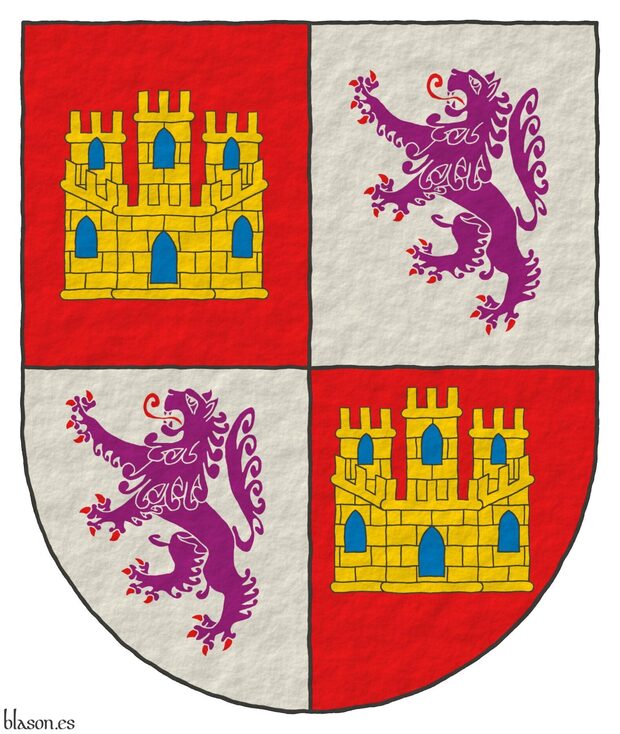
Quarterly: 1 and 4 Gules, a castle triple towered Or, port and windows Azure, masoned Sable; 2 and 3 Argent, a lion rampant Purpure, armed and langued Gules, crowned Or.
Escudo cuartelado: 1o y 4o de gules, un castillo de oro, aclarado de azur, mazonado de sable; 2o y 3o de plata, un león rampante de púrpura, armado y lampasado de gules, coronado de oro.
This coat of arms can be seen in [Bergshammars; 1440; page 2], in [Lutzelbourg, N. de; 1530; page 35] and in [Tewkesbury; 17th century; folio 25v].
Blazon keywords: Quarterly, Gules, Or, Azure, Sable, One, Castle, Port and windows, Masoned, Argent, Purpure, Lion, Rampant, Armed, Langued and Crowned.
Style keywords: Semi-circular and Plain tincture.
Classification: Interpreted, Civic, Coat of arms, Kingdom of Castile and Leon and Canting.
Bearer: Castile and León.


Castile and León, open royal crown
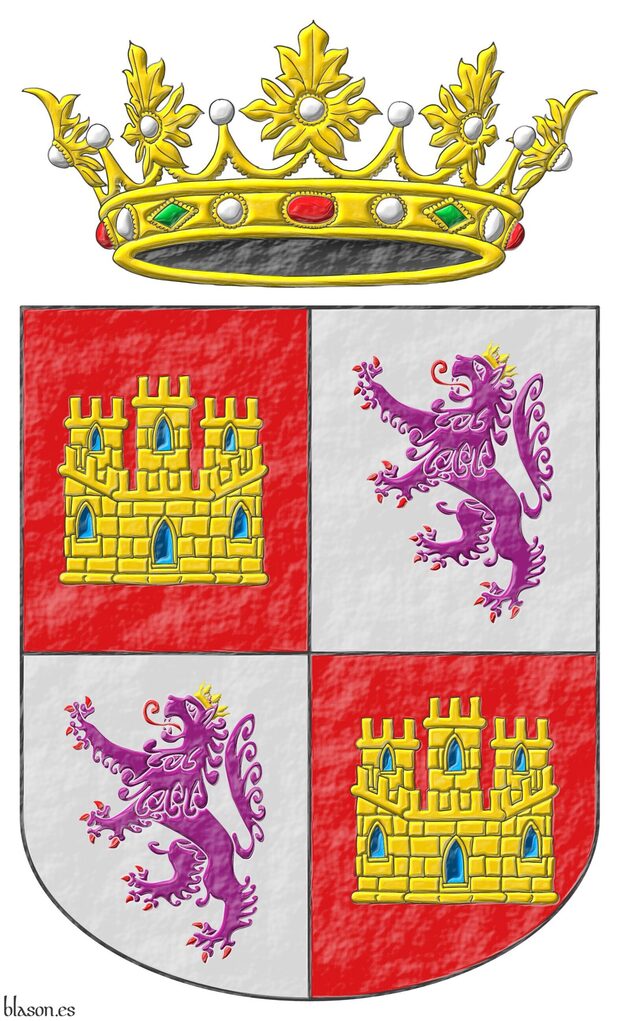
Quarterly: 1 and 4 Gules, a castle triple towered Or, port and windows Azure, masoned Sable; 2 and 3 Argent, a lion rampant Purpure, armed and langued Gules, crowned Or. Crest: An open royal crown Or.
Escudo cuartelado: 1o y 4o de gules, un castillo de oro, aclarado de azur, mazonado de sable; 2o y 3o de plata, un león rampante de púrpura, armado y lampasado de gules, coronado de oro. Timbrado de una corona real abierta.
Pre-existing arms interpreted by me as follows: the shield of arms has a rounded (semicircular) base; the quarterly field, the two castles and the two lions are illuminated; the lion and its crown are outlined in the colour of the field; the open royal crown and the castle are outlined in Sable, in the case of the castle because it is masoned; and the whole has a painted plaster finish.
In [Medél, R.; 1846; plate 10, illustration 4] his interpretation of the arms of Castile and León can be seen.
For the expression «a Castle triple towered» in the English blazon, I have followed [Burke, B.; 2009; pages 12, 27, 41, 51, 76, 104, 106, 109, 150, 159, 171, 189, 200, 226, 273, 281, 282, 287, 322 and others], where it is used more often with a hyphen «triple-towered» and less often without a hyphen «triple towered», which is the form I have chosen.
Blazon keywords: Quarterly, Gules, Or, Azure, Sable, One, Castle, Port and windows, Masoned, Argent, Purpure, Lion, Rampant, Armed, Langued, Crowned, Crest, Open royal crown and Crown.
Style keywords: Rounded, Illuminated and Gesso.
Classification: Interpreted, Civic, Coat of arms, Kingdom of Castile and Leon and Canting.
Bearer: Castile and León.


Castile and León, framed
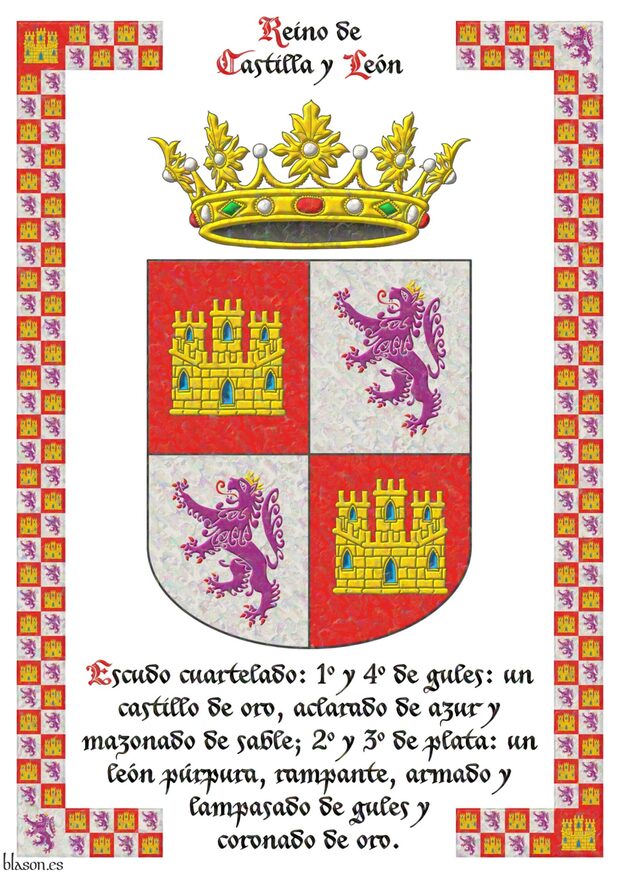
Quarterly: 1 and 4 Gules, a castle triple towered Or, port and windows Azure, masoned Sable; 2 and 3 Argent, a lion rampant Purpure, armed and langued Gules, crowned Or. Crest: An open royal crown Or.
Escudo cuartelado: 1o y 4o de gules, un castillo de oro, aclarado de azur, mazonado de sable; 2o y 3o de plata, un león rampante de púrpura, armado y lampasado de gules, coronado de oro. Timbrado de una corona real abierta.
Arms of the Kingdom of Castile and León created by me as follows: the shield of arms has a rounded (semicircular) base; the quarters are illuminated in flat tinctures Argent and Gules; the castles, lions and crown are illuminated; the lion and its crown are outlined in the colour of the field; the open royal crown; the royal Castilian castle is masoned, that is, outlined in Sable; the whole has an iridescent finish; and the owner, the shield and its blazon are framed within a border representing the arms of the Kingdom, this frame resulting from the combination of 76 small castles and 2 large ones at the corners with 76 small crowned lions and 2 large lions at the other corners;
In the armorial [Urfé; 15th century; page VIII of the index and page 140 of the contents], reference is made to and the arms of Castile and its kings are blazoned in French, describing its castle and its purple lion crowned Or and rampant.
Blazon keywords: Quarterly, Gules, Or, Azure, Sable, One, Castle, Port and windows, Masoned, Argent, Purpure, Lion, Rampant, Armed, Langued, Crowned, Crest, Open royal crown and Crown.
Style keywords: Rounded, Illuminated and Iridescent.
Classification: Interpreted, Civic, Frame, Kingdom of Castile and Leon and Canting.
Bearer: Castile and León.

Continue with: Banner of Castile and León.
-
Language
-
Categories of heraldry
-
Divisions of the field
- Without divisions
- Party per pale
- Party per fess
- Party per bend
- Party per bend sinister
- Tierce
- Tierce sinister
- Tierced per pale
- Tierced per fess
- Tierced per bend
- Tierced pallwise inverted
- Quarterly
- Quarterly per saltire
- Gyronny
- Party per fess, the chief per pale
- Party per pale, the sinister per fess
- Party per fess, the base per pale
- Party per pale, the dexter per fess
- Chapé
- Chaussé
- Embrassé
- Contre-embrassé
- Party per chevron
- Enté
- Enté en point
- Flanched
-
Metals
-
Colours
-
Furs
-
Other tinctures
-
Ordinaries and sub-ordinaries
-
Diminutives of the ordinaries
-
Other charges
-
Charges from Nature
Water, Eagle, Bald eagle, Eagle claw, Dorsal fin, Tail fin, Two hands clasped, Lark, Tree, Trunk, Rainbow, Atom, Barbel, Acorn, Bighorn sheep, Arm, Owl, Vulture, Horse, Head, Goat, Camellia, Thistle, Merino ram, Kapok tree, Stag, Doe, Crescent, Increscent, Chrysanthemum, Tail, Tail addorsed, Ermine spot, Hummingbird, Snowflake, Heart, Roe deer, Neck, Stags' attires, Roe deers' attires, Raven, Dolphin, Diamond, Tooth, Elephant, Beetle, Emerald, Starling, Mullet, Mullet of four points, Star of David, Estoile, Male figure, Fleur de lis, Flower, Cornflower, Dogwood flower, Lotus flower, Hop cone, Bluebonnet, Puffin, Ash, Rooster, Claw, Talon, Goose, Heron, Seagull, Pomegranate, Sunflower, Swallow-tail, Falcon, Leaf, Boar, Goldfinch, Laurel, Barn owl, Lion, Lioness, Lion passant, Leopard, Lion rampant guardant, Lynx, Lily, Madonna lily, Flame, Wolf, She-wolf, Parrot, Moon, Hand, Apple, Apple tree, Sea, Martlet, Wing, Two wings in vol, Covert, Blackbird, Mount, Trimount, Fly, Wrist, Elm, Olive tree, Orbital, Bear, Palm frond, Palm tree, Dove, Poplar leaf, Panther, Jaguar, Vine, Paw, Forepaw, Foot (palmiped), Foreleg, Peacock, Chest, Pelican, Pelican in her piety, Dog, Brach hound, Warren hound, Fish, Hoof, Beak, Quill, Cinquefoil, Quetzal, Branch, Sprig, Frog, Shamrock, Caboshed, Oak, Holm oak, Rose, Double rose, Savage, Serpent, Plough of Ursa Major, Sun, Sun in splendour, Ray of the sun, Lightning flash, River, Stem, Badger, Tyger, Linden, Wheat, Wheat spike, Bull, Tulip, Udder, Escallop and Fox.
-
Artificial charges
Halberd, Plough share, Ace of spades, Anchor, Cyclamor, Torch, Bow, Arch, Harp, Non-classic artifact, Winnowing fan, Crozier, Conductor's baton, Pair of scales, Ship, Oar, Sail, Norman ship, Beret, Grenade, Ecclesiastical cap, Arm vambraced, Knight, Chain, Cup, Covered cup, Monstrance, Bell, Bell tower, Cannon dismounted, Carbuncle, Castle, Ribbon, Clarion, Nail, Crucible, Cord, Dagger, Key ward, Turret, With a turret, Armillary sphere, Sword, Federschwert, Sabre, Parchment, Scroll, Arrow, Club, Garb, Sheaf of tobacco, Scythe, Gauntlet, Axe, Buckle, Galician granary, Host, Bonfire, Polish winged hussar, Church, Fanon, Oil lamp, Spear, Spear's head, Fleam, Letter, Book, Open book, Closed book, Bookmark, Page, Line, Lantern, Key, Four crescents joined millsailwise, Hammer, Menorah, Mortar, Pestle, Number, Knot, Celtic Trinity knot, Water-bouget, Comb, Piano, Millstone, Millrind, Millwheel, Clay pot, Potent, Bridge, Cuffed, Hourglass, Chess rooks, Compass rose, Rosette of acanthus leaves, Mullet of six points pierced, Broken, Portcullis, Wheel, Wagon-wheel, Symbol, Sackbut, Drum, Geometric solid, Tetrahedron, Tower, Trident, Trumpet, Double vajra and Anvil.
-
Immaterial charges
Angel, Archangel, Basilisk, Heart enflamed, Sacred Heart of Jesus, Paschal lamb, Dragon's head, Dragon, Wyvern, Phoenix, Garuda, Griffin, Sea-griffin, Winged hand, Our Lady of Mercy, Pegasus, Saint George, Mermaid, Trinity, Triton, Golden fleece, Unicorn and Ouroboros.
-
External elements
-
Heraldic creations
-
References
-
Formats
-
Keywords on this page
Port and windows, Old parchment, Armed, Azure, Flag, Castile and León, Castle, Catalogue, Crest, Ogee, Crown, Open royal crown, Crowned, Party per fess, Crystalline, Cross, Cross patty, Cross couped, Quarterly, Outlined in sable, Heraldic document, Fabric, Gesso, Coat of arms, Gules, Illuminated, Interpreted, Iridescent, Langued, Lion, Frame, Masoned, Semi-circular, Metal beaten, Or, Our Lady of Mercy, Order of, PDF, Pale, Canting, Banner of arms, Argent, Civic, Purpure, Rampant, Rounded, Kingdom of Castile and Leon, Religious, Sable and One.
